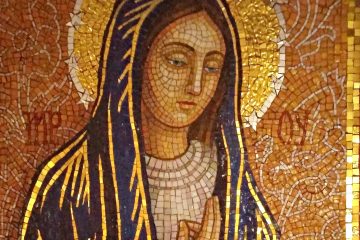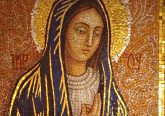For 30 years, Miami Catholic has watched over image of Cuba’s patroness

IMAGE: CNS photo/Ana Rodriguez-Soto, The Florida Catholic
By Rocio Granados
MIAMI (CNS) — On Sept. 8, hundreds of Catholics from Cuba and other Latin American countries are expected to gather at the University of Miami to mark the annual feast of Our Lady of Charity, patroness of Cuba.
But probably no one knows more about Our Lady of Charity than Rogelio Zelada.
He has composed hymns in her honor, written about her, restored and dressed her image and made other images of her. For more than 30 years, Zelada has been the custodian of the image at the National Shrine of Our Lady of Charity in Miami.
Zelada is associate director for Hispanic formation in the archdiocesan Office of Lay Ministry, as well as a member of the executive committee of the National Hispanic Institute of Liturgy. He also has served on the U.S. bishops’ Subcommittee on Divine Worship in Spanish.
He arrived in Miami from Puerto Rico after leaving Cuba in 1980. When Miami’s late, beloved auxiliary bishop, Agustin A. Roman, rector of the shrine, learned of Zelada’s work, he asked him to restore the image housed at the shrine in preparation for St. John Paul II’s visit in 1987.
The image had arrived in the U.S. from Cuba in 1961 and had never been restored. The paint had faded and the garments were damaged.
The restoration transformed the image, Zelada said, noting: "The dress has to convey, symbolically, what the image represents. It’s not just about dressing her. The dress is the Virgin. The dress must transmit the religious feeling, the love, the strength. The beauty of the image must transmit the beauty of Mary."
Nearly all the patronesses of Latin America wear dresses atop images that are quite plain. Many of these images are very famous but would be unrecognizable without their dresses.
Zelada commissions seamstresses to make the dresses because he can’t sew — but he knows how images from earlier times were dressed. When he commissions a garment, he tries to imbue it with meaning, something related to the life of Mary or the history of Cuba. "I give the idea, but I also leave it up to the creativity of the seamstress," he said.
He currently has several people sewing dresses with the idea to keep several in reserve, because, as he said, it’s hard to find "people who have the patience, good taste and skill to do it."
For the celebration of the 60th anniversary of the image’s arrival in Miami in 2021, Zelada has commissioned a special dress from a group of nuns in Spain made of "satin that is used for the outfits of bullfighters, with gold embroidery."
This year’s dress is made of old-gold lace with amber rhinestones. Every dress is a work of art that can’t be exposed to the elements, Zelada explained, because light causes the fabric to deteriorate.
"The idea is for her to wear a new dress each September 8," he said, then switch to an older one for special occasions such as Holy Week, Pentecost and Christmas.
Only quality materials are used when creating the dresses: Swarovski crystal, cultured pearls, silks and lace. "The materials are costly, but more so is the labor. It takes many hours of work," Zelada said.
In 1994, someone tried to steal the image at the shrine, so since then it has been placed in an urn made of a very heavy, bulletproof material.
For years, Zelada was the one who took the image out of the urn at the Sept. 8 celebration and changed its dress — not an easy task, he added. The dress must fall evenly on each side then the ornamentations are added: such as a medal from Cuba’s independence fighters, made of gold molded from the votives brought by the faithful in thanksgiving for favors granted.
The image also has a gold, bejeweled pin surrounded by 11 pearls representing the 11 dioceses of Cuba, and six corals representing the old provinces of Cuba. It has a rosary because St. John Paul II put one on the original image of Our Lady of Charity that he crowned during his 1988 stop in Cuba. On its neck is a pendant filled with Cuban soil.
Zelada said he started making images of Cuba’s patroness because she "got me into all this mess." Although he has some manual skills, he acknowledged, his forte is music.
When he was first asked to make a replica of Our Lady of Charity to raffle off at a Sept. 8 celebration in 1987, he had already made an image of St. Mary Magdalen for his parish in Cuba. And he knew a bit about restoring antiques because he took a course on the subject back when he was a seminarian and Havana’s cathedral was being restored.
To make the image for the raffle, Zelada said he started with an image of Our Lady of Charity purchased at a local Cuban store. He took it completely apart and shaped it the way he wanted.
He has made those images for 32 years now, some years making two, one to be raffled in September and the other in December. Because he is not a sculptor, making the images takes a long time. He works on them in between his work at the pastoral center and the classes he teaches at night.
Zelada has made images of Our Lady of Charity for St. Agatha Parish in Miami, San Lazaro in Hialeah, St. Mary Star of the Sea in Key West and St. Joseph in Miami Beach.
"Being the custodian of this image," he said, "means guarding a very important symbol of our Cuban identity and of the reality of our faith."
The annual celebration of the feast of Our Lady of Charity takes place Sept. 8, at the Watsco Center on the University of Miami to accommodate expected crowds. The traditional artistic and musical vigil in honor of Cuba’s patroness will take place Sept. 7 at the National Shrine of Our Lady of Charity.
– – –
Granados is a staff writer for La Voz Catolica, Spanish-language newspaper for the Miami Archdiocese.
– – –
Copyright © 2019 Catholic News Service/U.S. Conference of Catholic Bishops. www.catholicnews.com. All rights reserved. Republishing or redistributing of CNS content, including by framing or similar means without prior permission, is prohibited. You may link to stories on our public site. This copy is for your personal, non-commercial use only. To request permission for republishing or redistributing of CNS content, please contact permissions at [email protected].













